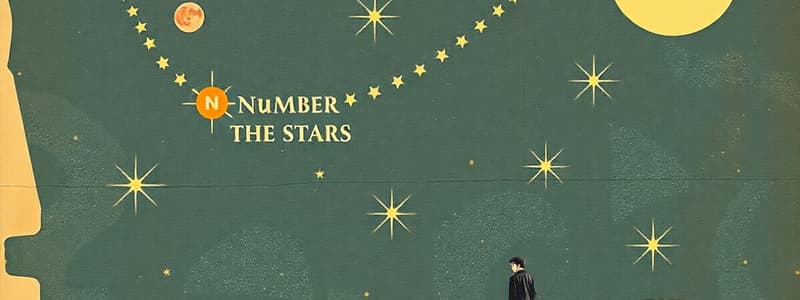Podcast
Questions and Answers
Considering the socio-historical context of children's literature and reception theory, which of the following represents the most nuanced interpretation of why Number the Stars continues to resonate with contemporary audiences?
Considering the socio-historical context of children's literature and reception theory, which of the following represents the most nuanced interpretation of why Number the Stars continues to resonate with contemporary audiences?
- The novel's enduring popularity primarily stems from its accessibility within educational curricula, ensuring its consistent exposure to new generations of readers irrespective of its thematic depth.
- The book's success is rooted in its capacity to facilitate intergenerational dialogue, where parents' nostalgic connection to the text intersects with emerging moral frameworks in their children, creating a shared interpretive space.
- The narrative's capacity to evoke empathy through identification with a child protagonist facing extraordinary circumstances fosters a deep, affective response that transcends temporal and geographical boundaries. (correct)
- The overt simplicity of the narrative structure allows for easy translation across diverse cultural contexts, thereby rendering its moral lessons universally accessible and perpetually relevant.
Given the author's reflection on readers 'matching themselves against the protagonists,' and acknowledging the developmental psychology of a ten-year-old's moral reasoning, what cognitive process MOST directly influences a young reader's engagement with the themes of Number the Stars
Given the author's reflection on readers 'matching themselves against the protagonists,' and acknowledging the developmental psychology of a ten-year-old's moral reasoning, what cognitive process MOST directly influences a young reader's engagement with the themes of Number the Stars
- The reader's concrete operational stage allows for a direct mapping of the characters' actions onto their own potential behaviors in similar scenarios, fostering both empathy and moral introspection. (correct)
- The reader's nascent capacity for abstract thought enables them to extrapolate the novel's historical specificity to broader ethical principles applicable in contemporary society.
- The reader's formal operational ability facilitates a critical deconstruction of the narrative's ideological underpinnings, leading to a nuanced understanding of its implicit biases and power dynamics.
- The reader's pre-operational egocentrism impedes a comprehensive understanding of the collective resistance, limiting their interpretation to individual acts of bravery.
Considering the author's emphasis on the age of ten as a formative period for value development, and integrating principles of moral psychology, which micro-processes underlies the capacity of Number the Stars to influence a young reader's ethical framework?
Considering the author's emphasis on the age of ten as a formative period for value development, and integrating principles of moral psychology, which micro-processes underlies the capacity of Number the Stars to influence a young reader's ethical framework?
- Episodic memory encoding associates the narrative's emotional intensity with specific moral lessons, creating a durable, context-dependent ethical schema.
- Emotional contagion effects amplify the reader's susceptibility to the author's didactic intent, resulting in uncritical acceptance of the promoted value system.
- Mirror neuron activation facilitates experiential learning whereby readers vicariously internalize the moral choices of the characters, thereby consolidating their own value structures. (correct)
- Cognitive dissonance resolution drives the child to reconcile the apparent contradictions within the narrative, leading to a more sophisticated understanding of ethical relativism.
Employing a reader-response criticism lens, and focusing on the author's observations about the book's continued relevance, what is the most likely mechanism by which adult readers, who encountered Number the Stars in their youth, transmit its significance to their children?
Employing a reader-response criticism lens, and focusing on the author's observations about the book's continued relevance, what is the most likely mechanism by which adult readers, who encountered Number the Stars in their youth, transmit its significance to their children?
Considering the concept of 'horizon of expectations' within reader-response theory, and assuming a contemporary reader engaging with Number the Stars for the first time, which factor most significantly mediates their interpretation compared to a reader from 1989?
Considering the concept of 'horizon of expectations' within reader-response theory, and assuming a contemporary reader engaging with Number the Stars for the first time, which factor most significantly mediates their interpretation compared to a reader from 1989?
Flashcards
Newbery Medal
Newbery Medal
An award for outstanding children's literature in the U.S.
Annemarie's Age
Annemarie's Age
Annemarie is ten years old in 'Number the Stars'.
Reader Identification
Reader Identification
Readers often see themselves in characters and their choices.
Emotional Connection
Emotional Connection
Signup and view all the flashcards
Values Development
Values Development
Signup and view all the flashcards
Study Notes
Introduction to Number the Stars
- Author wrote the book more than 20 years ago
- Book awarded the 1990 Newbery Medal
- Often discussed/researched now, but seems to have lasting appeal
- Many readers still excited to read it
- Readers of all ages enjoy the protagonists in books
- Focus on the age of the characters and readers (10 years old)
Studying That Suits You
Use AI to generate personalized quizzes and flashcards to suit your learning preferences.




